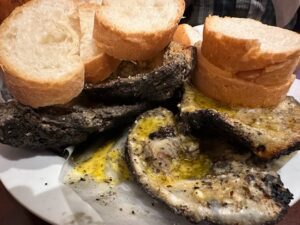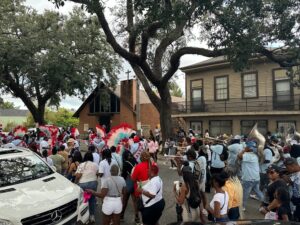
On our fourth day here, the air continued to hang heavily, warm and weighted with moisture. But it wasn’t horrible as we took a short stroll through the Mid City neighborhood to Katie’s, our choice for the morning’s brunch.
Where Joey K’s atmosphere—upon first walking in—was immediately defined by a playful aesthetic with its bright, colorful signs that predicted an equally colorful and zesty meal, Katie’s initially presented an impression that we were in for some standard pub fare, unimpressive chairs and tables matched by equally drab walls, with only a brilliantly silver tin ceiling suggesting any semblance of a glimpse towards the amazing meal we were about to have.
Positive glimpses of the future remained elusive as we ordered their mimosa service: a standard bottle of bubbles served with orange juice in a disposable cup, accompanied by three empty plastic glasses for us to mix our drinks. However, looks—as with book covers—can be deceiving, and soon drinking mimosas out of substandard plastic revealed an alluring charm that pointed towards something altogether different, and Katie’s was soon to become a favorite place of all the places we’ll have dined at in New Orleans.

By the time our chargrilled oysters arrived—shells piping hot, having just been removed from the oven seconds beforehand, upon which rested a mollusk drowning in butter, black pepper, and garlic, all served with a thickly sliced baguette to soak up all the guilty sins—it occurred to us that this is how oysters from the gulf are to be served: completely drenched in a ridiculous display of fat and flavor, chargrilled to perfection. If you have time only for one thing at Katie’s, then do get their chargrilled oysters. Absolute heaven!
We finished off our decadent brunch with soft shell benedict and crawfish beignets—the crab deep fried in a thick batter, legs gracefully curled beneath poached eggs that were untidily but joyfully immersed in a bright yellow hollandaise (“Doesn’t even need any tabasco,” we observed)—and felt thereafter immediately satiated and overwhelmingly and pleasantly satisfied, and so it was time to head to our next stop, Sportsman Corner Bar on Dryades Street in the Faubourg Delassize neighborhood (“This used to be a rough neighborhood,” our Lyft driver remarked).
This was the location of the start of the second line parade that we were about to partake in, and how much I can’t overstate how unbelievably amazing an experience it was to—once again—participate in this incredible New Orleans tradition, having first experienced it in 2015 the first time Amy and I visited. Revelers were already congregating in the streets well before the 1:00pm commencement, participants dressed mainly in street clothes while dotted throughout were the royalty of the parade, ladies and gentlemen dressed in vibrantly red, fancy dresses and blindingly white, trimmed suits, and they in turn were accompanied by the so-called “Mardi Gras Indians,” dancers decorated with tall, feathery adornments, as a brass band blared cheery music to glorify a celebration of intense happiness.

According to the second line link I referenced above: “Historically, the African-American community began second lines as neighborhood celebrations. The neighborhood organizations offered social aid to freed slaves, such as loans and insurance, and used the second-lines [sic] as a form of advertising. Second lines were also used to honor members who died in their community, which launched the idea of second lines at funerals.” Additionally, this resource elaborates: “The term ‘second line parade’ refers to those who join in the rolling excitement. The people who are part of the hosting organization are the ‘first line’ of the parade while those who follow it along, dancing and often singing as they go, form what is known as the ‘second line’.”
Before the parade got underway, however, we naturally had to refill our empty hands with cups of booze, so we discovered a woman selling liquor and accompanying mixers out of the back of her faded red Chrystler. Aaron asked, “Could we have margaritas made with mezcal?” pointing towards some bottles with a golden liquor. “What’d y’all call that? Where y’all from?” the lady cheerfully inquired with a hefty laugh. “Er… Minnesota,” we sheepishly admitted and then quickly realized only tequila was available and not its cousin. Regardless, she served us up some drinks for the road and not before long we were under way.
Our hosts for this week’s second line (they usually occur on Sunday afternoons, this one from 1:00 to 5:00pm) were the Men of Class, one of the many social aid and pleasure clubs that organize the weekly second line. We were all accompanied by the brass bands Da Truth and To Be Continued, both performing gloriously vibrant music noisily and powerfully with trumpets, trombones, sousaphones, cowbells, washboards, drums, and cymbals struck by screwdrivers. Meanwhile, the royalty dressed in their blazing red and shocking white rode on floats while long lines of Mardi Gras Indians—wearing regalia embellished with bejeweled lobsters and headdresses adorned with tall plumes of red, blue, and pink feathers radiating outwards in an arc —danced in the streets to the cheerful music.

These parades are nothing short of a test of stamina for the musicians and the dancers, sweat bleeding through polyester suits, embouchures of infinite endurance producing music that never faded from anything short of uncountable decibels, trumpets blasting the highest notes of catchy, syncopated, repetitive tunes. We marched with the second line for a good two hours before we felt the need to have a sit-down (and we weren’t even expending that much energy compared to the other revelers), so we departed as the second liners continued on northwest up Martin Luther King Jr. Boulevard at South Claiborne Avenue until they eventually would circle all the way back to the Sportsman Corner Bar. What an experience! What a celebration! What a tradition! What joy! What happiness! What bliss! If it isn’t obvious, this is me telling you that you must seek out a Sunday second line parade. It is uniquely New Orleansian and an incredible cultural gem that will live longer than time!
The parade slowly faded from view and the music became an indelible memory as we headed southeast down the central, grassy boulevard of Martin Luther King Jr., and we stumbled across Glady’s Bar. When we tried the front street entrance of the tiny establishment painted a bold red, a lady told us to go around to the side. So we did and we entered the bar, Marvin Gaye’s “Let’s Get It On,” playing on the jukebox, to discover we were the only white people in the whole place. We had surmised that this was going to be the case before we entered, so it wasn’t surprising at all when our assumption was validated.
While we enjoyed our drinks—the bartender gracefully serving us margaritas and observantly checking in with us when our glasses ran dry—so many questions and observations entered my mind. Was it okay for us to be here? Should we not have come inside? Were we invading a Black space that should be allowed to be completely Black? At the same time, I was so grateful for this experience so that I could see that Black folks do have Black spaces that are uniquely theirs, I just remain slightly apologetic if we disrupted a sacred space unnecessarily by simply being there.

Moving on from Glady’s, we hopped from bar to bar down Saint Charles Avenue (but not before waiting underneath an awning of a First Horizon bank while a sudden and brief downpour deluged the city). Our first stop was Lucky’s—a 24 hour bar in a converted house with elegant woodwork and a dark, ornate, tiled, copper-hued ceiling where the bartender asked us, “Is well vodka okay?” which is Southern speak for rail vodka—and then onwards to Bayou Bar within Pontchartrain Hotel—a fancier establishment compared to Lucky’s but with interminably slow service even at the slightly more lackadaisical pace to expect in the South, our manhattan drinks arriving after several ages, a lady standing at the bar for several minutes before eventually just giving up and going elsewhere, annoying people from a wedding just milling about and taking up space, our snack of fried calamari pale and lifeless and soggy, something I’d expect to eat at a Red Lobster—before we landed on our last stop before dinner, heading upstairs to the hotel’s rooftop bar, Hot Tin.
Hot Tin was my favorite of the bars we visited on Saint Charles, as not only were the cocktails expertly prepared (one drink with a Star Wars name, Young Padawan, and prepared on time, no less), but also because its location on the 12th story (of the two elevators in the lobby, the one on the right seeming to have access to the correct floor) offered gorgeously panoramic and openair views of New Orleans. If you are someone who—like me— experiences intrusive thoughts where you feel you might lose control of your senses and just throw yourself off over the edge, you’ll definitely experience that here. There was a pair of two old lesbians nearby also enjoying cocktails, and I was eyeing a section of roofing sitting slightly lower and adjacent to our rooftop platform, and I jokingly exclaimed, “I just gotta jump!” I didn’t, of course. It was really a remarkable view atop Hot Tin, and I highly recommend a visit so you can admire not only an incredible view of the city but also of the wide, grand Mississippi River.
Soon it was time for our dinner for the evening at a place called Lula—a more modern establishment with tall, drafty ceilings that belonged to an austere factory rather than a restaurant, and the air conditioning was set to a temperature much too cold, and the restaurant served food that was impossible to remember. The only part of the meal I do remember distinctly was the tomato stack we ordered, served over a hot garlic shrimp boil with fries. All I recall was that the fries were damp and soggy and the whole dish tasted strongly of vinegar and nothing else, the acetic acid burning holes through all other flavors and preventing anything else from mingling into any semblance of a sensible palette to be desired. I also wrote a note to myself that I had the pork osso buco, but I don’t have any memory of eating it or what it tasted like. That said, it’s quite an accomplishment for a place to leave a clear, lasting impression, but one of easily forgettable ephemera drifting off into the voids of fickle human memory.
We also might’ve just been so incredibly tired after all the excitement of the day, the second line parade a real highlight of not only this day but of our whole week. Indeed, it was precisely 8:21 when we left Lula to head home, old and drunk, feeling the aches and pains of middle age. And while we felt we ended the day on a dud, this was not a portent of doom to come as tomorrow we were to have quite a memorable day indeed!
Stray observations:
- While we were on the second line, we happened to spot Steven, the resident heartthrob from Verret’s Bar who we met on day 2, also partaking in the festivities.
- We also got to witness a small second line parade celebrating a wedding while atop Hotel Pontchartrain at Hot Tin, reminding us that second lines can happen anywhere and at any time and practically for any reason.
